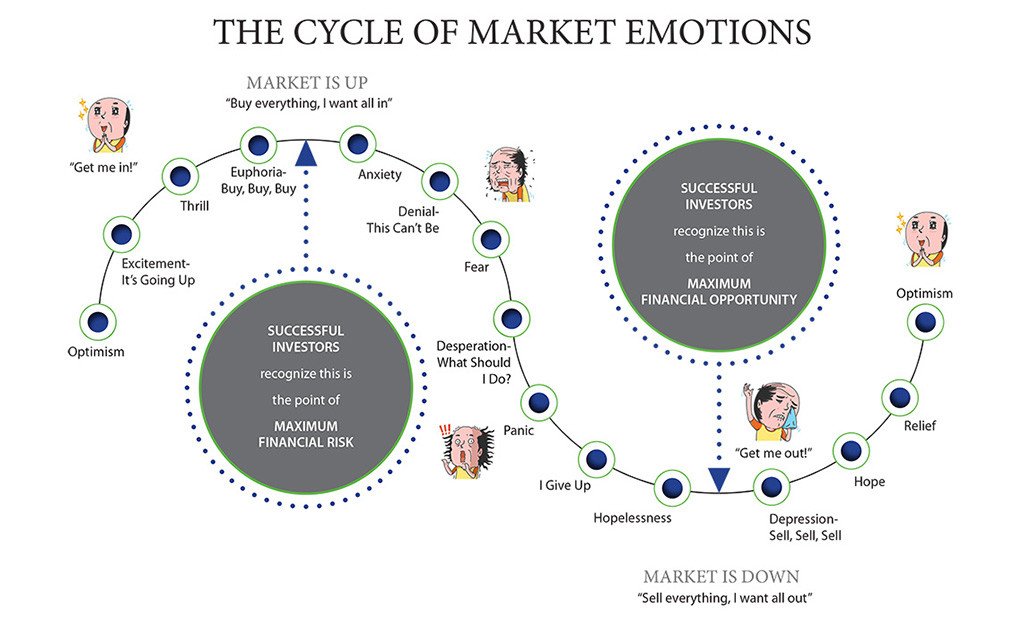The Business and Real Estate Cycle
For those who have taken Economics 101 (unlike me), feel free to skip past the business cycle down to the real estate cycle. For the rest of us, both of these cycles will likely be novel concepts.
You may ask yourself why we are even reviewing these cycles and how they impact your investment and lifestyle decisions. Firstly, the business and real estate cycles have been present ever since economists have been tracking markets, they are cyclical (duh, that’s why it’s called a cycle) and largely due to human nature and the fight we face between fear and greed. Until human nature changes, these cycles will be ever-present, so it’s best you understand what they are and how they may affect your investment decisions.
Speaking of fear and greed, there's is an actual index (fear and greed index) that tracks investor sentiment and it is often used as one of the tools in one’s investment framework.
Secondly, these cycles are underpinned by human emotions (see last section) and if I’ve learned anything by being a healthcare professional, human emotion, dictates action, and actions impact outcome. We soon may be tracking AI emotion (is that even a thing?) but until that day, one would be wise to understand these cycles and behavioural economics.
Over the next few paragraphs and with the aid of visual images, I attempt to break down the business/economic cycle, the real estate cycle, and the cycle of market emotions!
What is the Economic Business Cycle?
The Economic Business Cycle is a recurring pattern of expansion and contraction in the economy over time. For a great visual on how the economy works, please watch this, created by none other than Ray Dalio. Picture it as a perpetual rollercoaster ride, constantly moving through four significant phases: Expansion, Peak, Contraction, and Trough. Each phase plays a pivotal role in influencing economic performance.
Phase 1: Expansion (The Boom!)
In the expansion phase, the economy is on an upward trajectory, just like the exhilarating ascent of a rollercoaster. Economic indicators, such as Gross Domestic Product (GDP), employment rates, and consumer spending, are all on the rise. Businesses are flourishing, investments are soaring, and consumers are confident, resulting in increased economic activity. The Good Times.
Phase 2: Peak (The Top of the Ride)
The peak is the highest point of the Economic Business Cycle, mirroring the exhilarating moment at the summit of a rollercoaster. The economy is at its most robust, but it can't maintain this peak forever. As growth reaches its zenith, inflation might start to creep up, potentially causing challenges for businesses and consumers. This is where your mother, hair stylist, and your estranged uncle start talking bout the stock market. The Great Times. Right before the Bust.
Phase 3: Contraction (The Descend)
After reaching the peak, the economy gradually (sometimes a little steeper) starts to slow down, akin to the initial descent of a rollercoaster. During this contraction phase, economic growth decelerates, and businesses may face reduced demand, leading to layoffs and lower investments. Consumers might also become cautious with their spending. Greed turns more to fear and possible to panic.
Phase 4: Trough (The Bottom of the Ride)
The trough represents the lowest point of the Economic Business Cycle, similar to the bottom of a rollercoaster dip. Economic indicators like GDP and employment hit a low, and the economy experiences a slowdown. However, just as a rollercoaster doesn't stop at the bottom, the economic cycle also keeps moving forward. All hope is lost and people assume the bad times will continue to roll. "Buy when there's blood in the streets, even if the blood is your own."- Baron Rothschiel
Why does the Economic Business Cycle occur?
The Economic Business Cycle occurs due to the interplay of several factors. In the expansion phase, rising confidence and strong economic performance fuel further growth. However, this growth can lead to rising inflation and interest rates, prompting a slowdown in the economy during the contraction phase.
Central banks and governments play a crucial role in managing the cycle through monetary and fiscal policies. During contractions, they might lower interest rates or increase government spending to stimulate economic activity. Conversely, during expansions, they may raise interest rates or cut spending to prevent overheating and inflation.
The Business Cycle
Seeing this visual really helps drive home the cycle. The actual amplitude of the peaks and troughs will vary from cycle to cyle but the general trend remains. This is where amateur investors will mistakenly comment “you see, it’s easy to buy low and sell high”. Regrettably, I was in that same camp, however, even monkeys can predict historical data. Living in the moment and predicting outcomes is a lot more challenging.
Understanding the Real Estate Cycle
The Real Estate Cycle is a recurring pattern (why is it recurring?…. because human nature does not change) of expansion, peak, contraction, and trough that characterizes the fluctuations in property markets. Just like the Economic Business Cycle, it's akin to a rollercoaster ride, presenting us with exciting opportunities and daunting challenges along the way.
Phase 1: Recovery (The Market Awakens)
The cycle begins with the recovery phase, signaling the end of a period of economic downturn or stagnation. During this phase, property prices start to stabilize and gradually increase. Low-interest rates and increased demand for housing often contribute to the recovery.
Phase 2: Expansion (The Boom!)
As the recovery gains momentum, the market enters an expansion phase, reminiscent of the exhilarating ascent of a rollercoaster. Demand for real estate surges, resulting in a rise in property prices. Builders and developers respond to the growing demand by increasing construction activity. The expansion phase can be a period of significant growth and prosperity in the real estate market.
Phase 3: Hyper Supply (The Peak)
At the peak of the real estate cycle, the market experiences hyper supply, much like the peak of a rollercoaster ride. The rapid increase in construction during the expansion phase now leads to an oversupply of properties. As more properties become available, demand begins to wane, and price growth starts to slow down or even decline.
Phase 4: Recession (The Descend)
The real estate cycle enters a recession phase, akin to the descent of a rollercoaster ride. During this period, the market faces challenges with declining property prices and reduced construction activity. Sellers may struggle to find buyers at desired price points, leading to a slowdown in property transactions.
Phase 5: Recovery (The Rise Again)
After experiencing the bottom of the cycle, the real estate market gradually moves towards recovery, just like a rollercoaster that begins its ascent again. Demand picks up, and property prices stabilize, creating new opportunities for investment and growth.
The Cycle of Market Emotions
Optimism: The cycle begins with "Optimism." In this phase, markets are usually recovering from a downturn or recession, and investors feel hopeful about the future. Positive economic indicators and favorable news create a sense of confidence among investors. As optimism grows, buying activity increases, leading to a gradual rise in asset prices.
Excitement: As markets continue to rise, "Excitement" sets in. Investors witness strong returns, and the media amplifies the positive sentiment, fueling a sense of euphoria. The fear of missing out (FOMO) drives more people to join the market (remember DOGECOIN, AMC, GAMESTOP), further pushing prices higher. However, caution is often thrown to the wind as investors become increasingly speculative and driven by short-term gains.
Thrill / Euphoria: During the "Thrill" phase, markets reach their peak, comparable to the exhilarating peak of a rollercoaster ride. Prices soar to unsustainable levels, driven by excessive optimism and speculative buying. At this point, investors feel invincible, convinced that the market will keep going up indefinitely.
Complacency (one of my least favourite words, alongside comfortable) As markets approach their peak, "Complacency" sets in. Investors become less cautious and start overlooking potential risks. They believe that nothing could disrupt the ongoing bull market. However, this lack of concern and preparedness can leave investors vulnerable to sudden downturns.
Anxiety: The "Anxiety" phase marks the beginning of a market decline. Initially, some investors might experience doubts and uncertainty, while others continue to hold onto hope. As negative news and economic indicators start to surface, fear and uncertainty intensify, leading to increased selling activity.
Denial: During the "Denial" phase, the market experiences a substantial decline, comparable to the descent of a rollercoaster. However, many investors refuse to accept the reality of a bear market. They may believe it's just a temporary setback and continue to hold onto their investments, hoping for a quick rebound.
Fear / Panic: In the "Fear" phase, the market faces a significant downturn, and fear takes hold of investors. Panic selling becomes prevalent as investors rush to exit their positions, leading to a sharp decline in asset prices. This phase can be compared to the bottom of a rollercoaster dip, where emotions run high, and rational decision-making is often compromised.
Capitulation (Get me Out). The "Capitulation" phase ( a fancy finance bro word) is characterized by a moment of surrender. Investors finally give in to fear and decide to sell their investments at any price to avoid further losses. This point often represents the market's bottom, as selling pressure becomes unsustainable.
Despondency / Depression: During the "Despondency" phase, market sentiment hits rock bottom. Investors feel despondent and disheartened, unsure if the market will ever recover. At this stage, asset prices may be at their lowest, presenting a potential opportunity for long-term investors.
Hope: The cycle completes with "Hope." In this phase, the market starts to stabilize, and some positive signs of recovery emerge. A few brave investors begin to cautiously re-enter the market, bringing back a sense of optimism and hope for better times ahead.
The Cycle of Market Emotions is a continuous and self-repeating pattern driven by investor psychology and market conditions. Recognizing these emotional shifts can help investors avoid common pitfalls, stay rational during market extremes, and make more informed investment decisions.
I believe if you understand human nature and emotion, you can be a leg above your neighbour. Our psyche hasn’t changed in hundreds of years, we are preprogrammed to act in a certain way. This is why I love to understand the business, real estate and the market emotional cycle.








There are always those people who profess that they can time the market. I’m definitely not one of those people. Instead I use a tried and true approach backed with evidence to shape my investing decisions.